This pork stir fry with snow peas is a simple dish to prepare, with a pleasing contrast of colors and textures. Crunchy pepper slices and snow pea pods with tender pork. The doubanjiang (red broad bean paste) gives the pork a bit of flavor and spice. However, this is a fairly mild dish: no hot chili peppers or Sichuan peppercorn.
Fried pork with snow peas is low in carbohydrates, high in protein, potassium, calcium, and vitamins A & C.
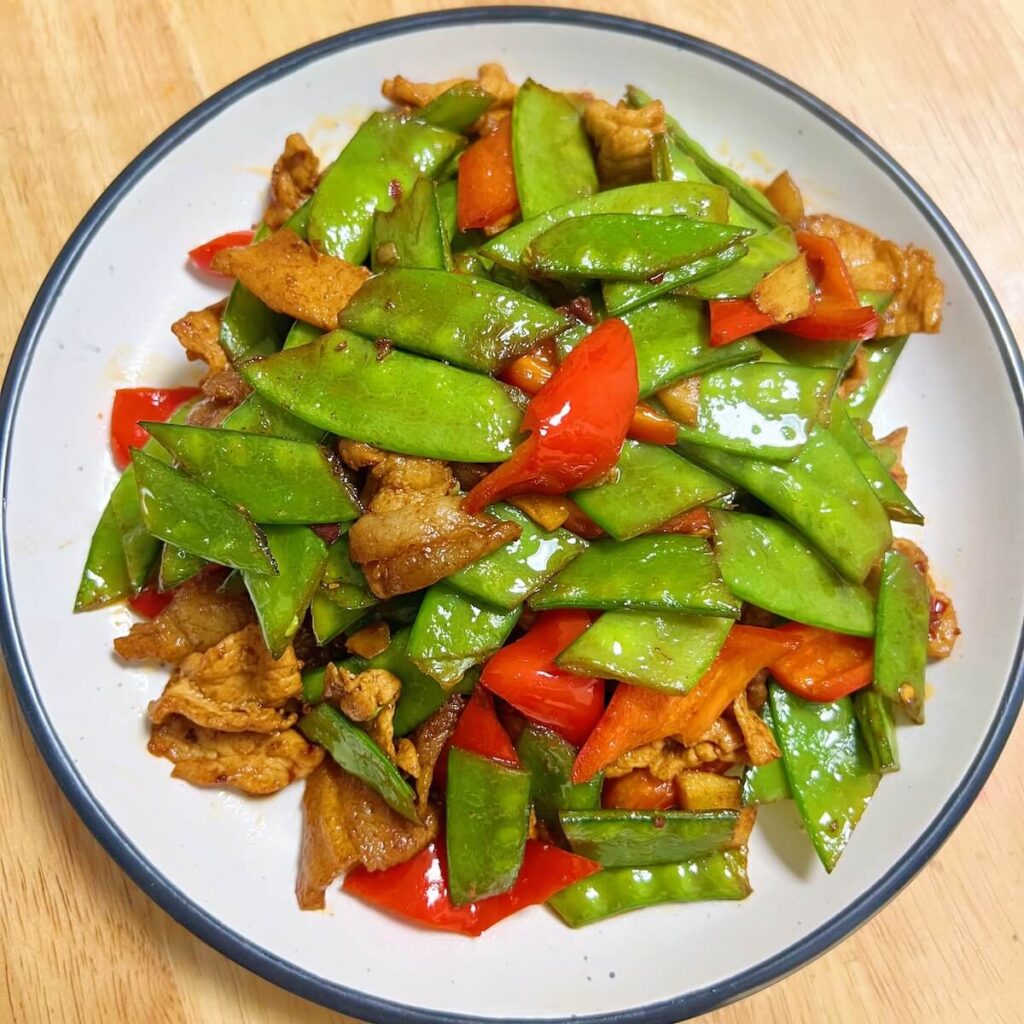
Cooking fried pork with snow peas
Do not let the term “stir-fry” mislead you. Stir-fry is a bad translation of words that mean to toss and tumble the ingredients in the wok. It is not about stirring, but turning and tossing for even cooking.
Another misconception about stir-frying is that you must cook with the pan smoking hot. This pork stir fry, like several other of our pork dishes (see Similar recipes below) uses low heat to render the pork fat and slowly cook the pork. High heat would sear the pork belly before it cooked through, making it hard and crunchy.
Blanching the snow peas
The snow peas are blanched, before being added to the the stir fry as the last step. The snow peas are added to the wok only long enough to toss and mix them in with the pork and the seasonings. This gives you cooked but crispy snow peas, instead of mushy snow peas, in your final dish.
To blanch the snow peas, first boil the water, then add the snow peas, bring the water back to a boil and then remove the snow peas after 5 seconds. Immediately plunge them into a bowl with ice water, or under a cold faucet, until all heat is removed, to stop the cooking.
If you have a saucepan, use that for boiling the water. If you boil water in a carbon steel or cast iron wok, the boiling water will strip the seasoning from the pan, causing food to stick. You will need to season the pan before cooking.
NOTE: This same technique is used to freeze or can vegetables. Blanching eliminates the enzymes that cause vegetables to break down into a slimy sludge, while bringing out the color and flavor. The vegetable is cooked on the outside, but the inside remains crispy.
Caiziyou oil with pork fat
Caiziyou and Canola oil both come from rapeseed. However, Canola oil is chemically processed and has a neutral flavor, whereas Caiziyou is roasted, and expeller-pressed, giving it a distinct flavor and aroma. Sichuan chefs often mix caiziyou one-to-one with lard or pork fat for the flavor and aroma. Not to worry if you don’t have caiziyou. You can use any cooking oil.
Stir-fried Pork with Snow Peas
Equipment
- 1 sauce pan
- 1 wok
- 1 wok spatula
- 1 sieve (for draining the snow peas)
- 1 heat safe container for hot oil
Ingredients
- 200 g snow peas
- 200 g pork belly
- 1 mild red pepper Anaheim or bell pepper
- 4 g fresh ginger
- 2 garlic
- 10 ml Pixian Doubanjiang bean paste
- 5 ml light soy sauce
- 2 ml sugar, white (granulated)
- 15 ml caiziyou roasted rapeseed oil substitute peanut oil, soybean oil, or vegetable oil
- 10 ml water
Instructions
Prepare the ingredients:
- Add water to a saucepan, enough to cover the snow peas, and set the heat to high to bring the water to a boil.
- Peel the ginger and garlic, wash the snow peas, pork, and pepper.
- Slice the pork belly, and separate the fat from the lean meat. Slice the pepper, ginger and garlic.
- Remove the head and tail of the snow peas and cut into half.
Blanch the snow peas:
- Add the snow peas to the boiling water in the sauce pan. Bring the water back to boiling, then remove the snow peas after 5 seconds and rinse with cold water to stop the cooking.200 g snow peas
Cooking:
- Add 15ml (1 tbsp) of oil to the wok over low heat, then add the pork fat, and stir-fry the fat over low heat to melt it down. Pour off half of the oil and rendered fat into a heat proof container, then add the lean pork. Stir-fry until the pork changes color, then add the ginger, garlic, and doubanjiang (bean paste). Increase the heat to medium, and stir-fry evenly until the doubanjiang is melted into the oil, then add the sliced pepper.200 g pork belly, 1 mild red pepper, 4 g fresh ginger, 2 garlic, 10 ml Pixian Doubanjiang bean paste, 15 ml caiziyou roasted rapeseed oil
- Season with the light soy sauce and sugar, and 10ml (2 tsps) of water. Add the snow peas and stir-fry evenly for 10 seconds to combine.5 ml light soy sauce, 2 ml sugar, white (granulated), 10 ml water, 200 g snow peas
- Finish.
Notes
- This recipe uses low and medium heat. The pork fat is rendered over low heat, the pork is cooked over low heat, and the garlic, ginger, and doubanjiang are added over low heat. Once the doubanjiang is melted and blended into the fat and oil, you increase the heat and add the sliced pepper.
- Unlike chemically-processed canola oil (which also comes from rapeseed), caiziyou is a roasted, expeller-pressed rapeseed oil and has a distinct flavor and aroma. You can order caiziyou from the Mala Market. If you prefer, any frying oil can be substituted.
- Blanching the snow peas brings out the color and flavor, while maintaining their crispy texture. Do not leave the snow peas in the boiling water for more than a few seconds, or they will become soft and mushy. Immediately after removing them from the boiling water, plunge them into ice water, or under cool tap water until they are cool. This stops the cooking, and keeps them nice and crispy.
- You can blanch the snow peas in your wok. However, boiling water will strip the seasoning from your wok. It’s best to use a second wok or a sauce pan for this step.
Nutrition
Similar recipes
All of these dishes use the technique of browning pork loin or pork belly over low to moderate heat in the wok as a first step in the cooking process, however, only two are stir-fries. Done properly, and with patience, you will get pork that is cooked, not overly fatty, and reasonably tender.
With the exception of the Sichuan Long Beans and Pork, all of these recipes are mild or moderately spicy. The Fujian Salty Rice (it’s not that salty) has no chili pepper at all.
Do you enjoy My Chinese Home Kitchen?
We enjoy sharing these authentic home recipes with you. My Chinese Home Kitchen is a labor of love.
Please tell your friends about us!
Learn more about My Chinese Home Kitchen at our About page.
Please leave a comment, or SUBSCRIBE to our newsletter.
For more of our original videos, visit My Chinese Home Kitchen on YouTube and Rumble.


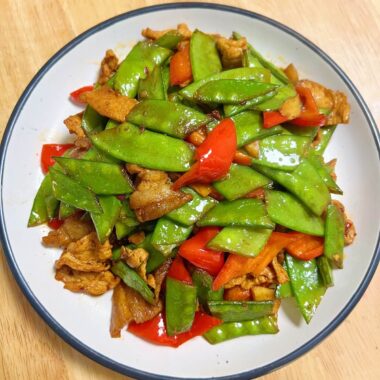
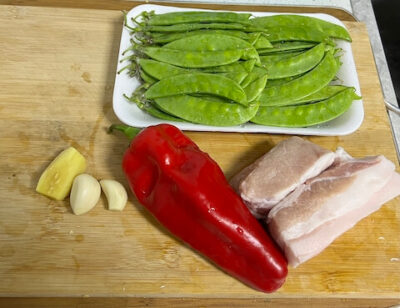
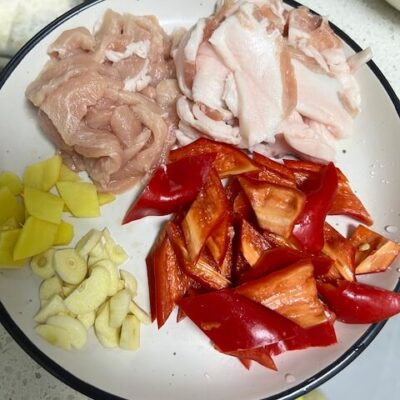
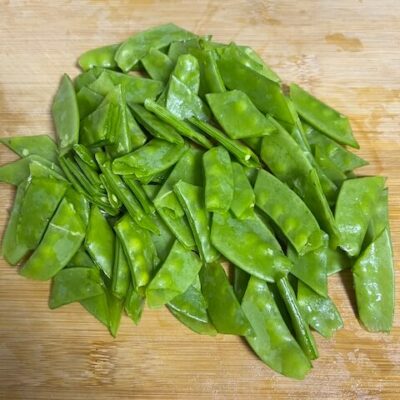
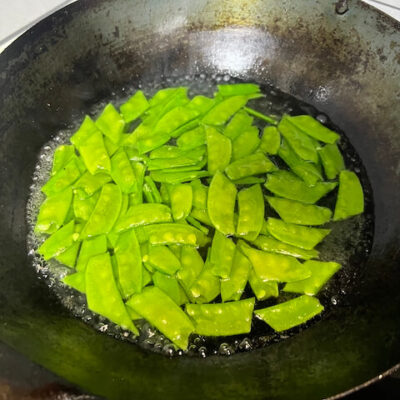
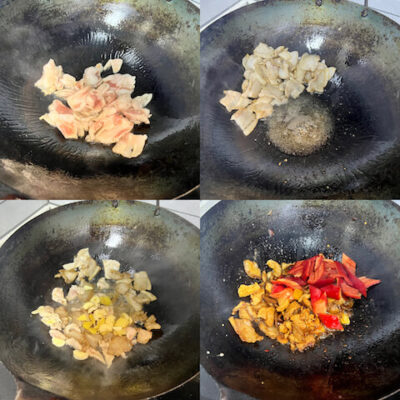
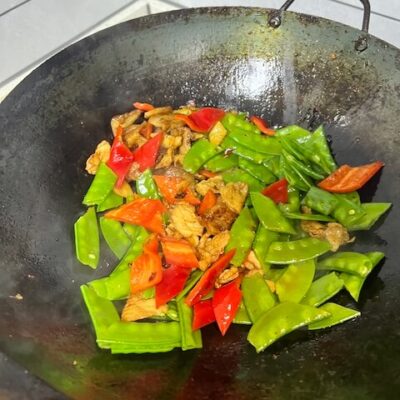
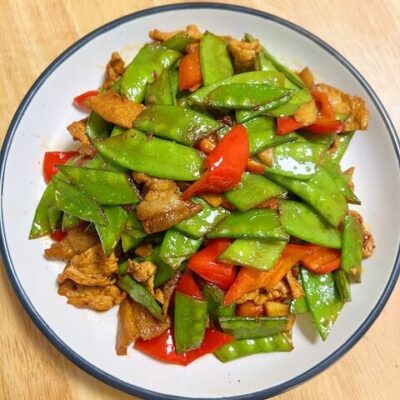

The stir-fry pork with snow peas looks good!!!